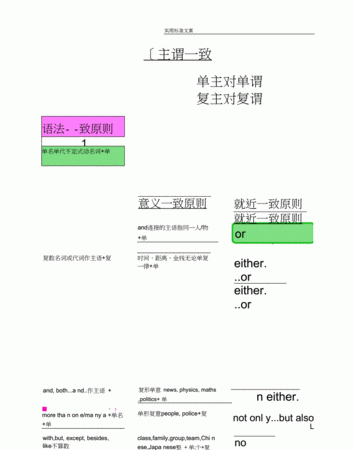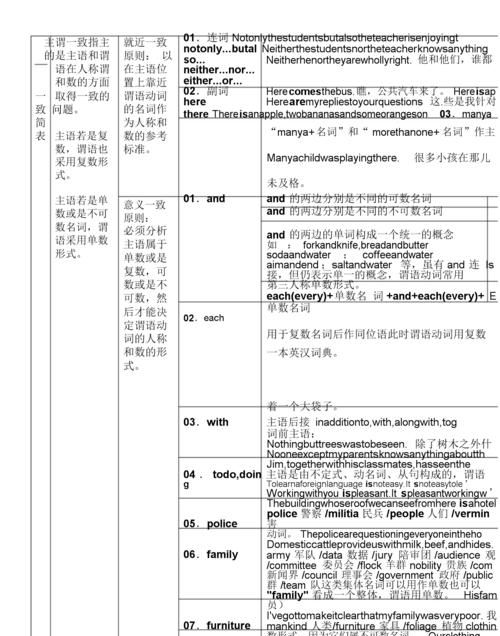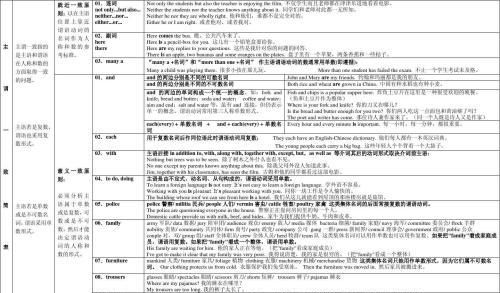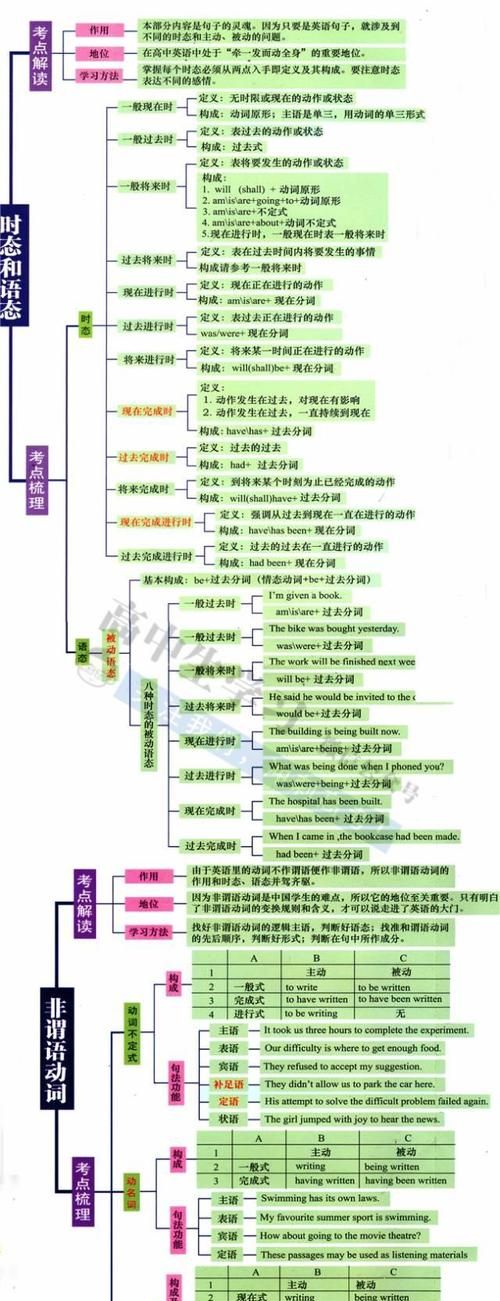本文目录
主谓一致形式一致
主谓一致的语法
一、最基本的"主谓一致"规则
初中课本中最基本的"主谓一致"规则是:"单则单,复则复",即主语为单数时,谓语动词也用相应的单数形式;主语为复数时,谓语动词也用相应的复数形式。例如:I am a teacher. We are teachers. 但要注意:当表示时间、长度、距离、金钱、度量等词组作主语时,常将其看作是一个整体,谓语动词要用单数形式。例如:Two years is quite a long time. Ten dollars is enough.另外,加减乘除也常当作整体对待,谓语动词也用单数形式。例如:Forty-one plus fifty-nine is one hundred. How much isninety-nine minus sixty-two?
二、集体名词作主语时,谓语动词的使用
family, class, team等集体名词作主语时,若指一个整体,谓语动词用单数形式;但若指其成员时,谓语动词用复数形式。例如:The family is very big. Their family arewatching TV now.
三、neither... nor..., either...or..., not...but...,not only... but also...等连词连接两个名词(或代词)作主语时,谓语动词要与靠近它的主语一致。例如:Neither he nor I know anything about it. Notonly the students but also the teacher has visited the museum. there be…结构也属于此类。例如:There is a teacher,a desk, a blackboard, some desks andsome chairs in the classroom.但要注意:both…and…表示"……和……都",谓语动词一般用复数形式。例如:Both his father and mother are doctors.
四、两个主语用and连接时,谓语动词的使用
and连接两个名词(或代词)作主语时,谓语动词一般用复数形式。例如:Mary and Helen are good friends.但要注意:and连接的两个名词只表示一个概念时,谓语动词要用单数形式。例如:A singer and dancer is coming.一个歌手兼舞蹈家就要来了。
五、politics, physics, works, the United States,news, maths等词作主语时,谓语动词的使用
这类形式上为复数,意义上却是单数的名词作主语时,谓语动词用单数形式。例如:The news is very exciting. Physics is a bitdifficult for me.但要注意有些名词,如:people(人;人们),police等则是形式为单数,意义是复数,谓语动词要用复数形式。例如:People there are very friendly
六、不定代词作主语时,谓语动词的使用
1.something, everything, anything, nothing,everybody, anybody, nobody, everyone, anyone等复合不定代词,以及either,neither(neither of), each (each of), each one, no one, another等代词作主语时,谓语动词用单数形式。例如:Neither of the answers is right. Somethingis wrong with my computer.
2. both, few, a few, many, several, others作主语,或它们所修饰的名词作主语时,谓语动词要用复数形式。例如:A few people can live to 100, but few canlive to 150. Both of them are in my class.
七、with, as well as, like等修饰的单数名词作主语,谓语动词的使用
单数名词作主语,且后面有with, as well as, like等修饰时,谓语动词用单数形式。例如:1.The teacher with his students has gone to the library. 2.Is the womanlike you your mother? 3.The instrument as well as other spare parts is going tobe airlifted soon. (该仪器以及其它一些备用件不久将空运。)
八、动词不定式(或动词不定式短语),V-ing形式以及名词性从句作主语,谓语动词的使用
动词不定式(或动词不定式短语),V-ing形式以及名词性从句作主语,谓语动词用单数形式。例如:1.To eat in a fast food restaurant is cheapand saves time. 2.Climbing hills is good exercise. 3.What interests the workersmost is better wages and workingconditions. (工人们最关注的是好的工资待遇和工作条件。

主谓一致专练及详解
在英语句子里,谓语受主语支配,其动词必须和主语在人称和数上保持一致,这就叫主谓一致。寻其规律,大致可归纳为三个原则,即语法一致、逻辑意义一致和就近一致原则。
一、语法一致原则
语法上一致就是谓语动词和主语在单、复数形式上保持一致。
1. 以单数名词或代词、动词不定式短语、动名词短语或从句作主语时,谓语动词一般用单数形式;主语为复数时,谓语动词用复数形式。如:His father is working on the farm. / To study English well is not easy. / What he said is very important for us all. / The children were in the classroom two hours ago. / Reading in the sun is bad for your eyes.
注意:由what引导的主语从句,后面的谓语动词多数情况用单数形式,但若表语是复数或what从句是一个带有复数意义的并列结构时,主句的谓语动词用复数形式。如:What I bought were three English books. / What I say and do is (are) helpful to you.
2. 由连接词and或both …… and连接起来的合成主语后面,要用复数形式的谓语动词。如:Lucy and Lily are twins. / She and I are classmates. / The boy and the girl were surprised when they heard the news. / Both she and he are Young Pioneers.
注意:(1)若and所连接的两个词是指同一个人或物时,它后面的谓语动词就应用单数形式。如:The writer and artist has come. (2)由and连接的并列单数主语前如果分别有no, each, every more than a (an) , many a (an)修饰时,其谓语动词要用单数形式。如:Every student and every teacher was in the room. / No boy and no girl likes it.
3. 主语为单数名词或代词,尽管后面跟有with, together with, except, but, like, as well as, rather than, more than, no less than, besides, including等引起的短语,谓语动词仍用单数形式;若主语为复数,谓语用复数形式。如:Mr. Green, together with his wife and children, has come to China. / Nobody but Jim and Mike was on the playground. / She, like you and Tom, is very tall.
4. either, neither, each, every 或no +单数名词和由some, any, no, every构成的复合不定代词,都作单数看待。如:Each of us has a new book. / Everything around us is matter.
注意:(1)在口语中当either或neither后跟有“of+复数名词(或代词)”作主语时,其谓语动词也可用复数。如:Neither of the texts is (are) interesting. (2)若none of后面的名词是不可数名词,它的谓语动词就要用单数;若它后面的名词是复数,它的谓语动词用单数或复数都可以。如:None of us has (have) been to America.
5. 在定语从句时,关系代词that, who, which等作主语时,其谓语动词的数应与句中先行词的数一致。如:He is one of my friends who are working hard. / He is the only one of my friends who is working hard.
6. 如果集体名词指的是整个集体,它的谓语动词用单数;如果它指集体的成员,其谓语动词就用复数形式。这些词有family, class, crowd, committee, population, audience等。如:Class Four is on the third floor. / Class Four are unable to agree upon a monitor.
注意:people, police, cattle等名词一般都用作复数。如:The police are looking for the lost child.
7. 由“a lot of, lots of, plenty of, the rest of, the majority of + 名词”构成的短语以及由“分数或百分数+名词”构成的短语作主语,其谓语动词的数要根据短语中后面名词的数而定。如:There are a lot of people in the classroom. / The rest of the lecture is wonderful. / 50% of the students in our class are girls.
注意:a number of“许多”,作定语修饰复数名词,谓语用复数;the number of“……的数量”,主语是number,谓语用单数。
8. 在倒装句中,谓语动词的数应与其后的主语一致。如:There comes the bus. / On the wall are many pictures. / Such is the result. / Such are the facts.
二、逻辑意义一致原则
逻辑意义一致就是谓语动词的数必须和主语的意义一致(因有时主语形式为单数,但意义为复数;有时形式为复数,但意义为单数)。
1. what, who, which, any, more, all等代词可以是单数,也可是复数,主要靠意思来决定。如:Which is your bag? / Which are your bags? / All is going well. / All have gone to Beijing.
2. 表示“时间、重量、长度、价值”等的名词的复数作主语时,谓语动词通常用单数形式,这是由于作主语的名词在概念上是一个整体,如:Thirty minutes is enough for the work.
3. 若英语是书名、片名、格言、剧名、报名、国名等的复数形式,其谓语动词通常用单数形式。如:“The Arabian Nights” is an interesting story-book.
4. 表数量的短语“one and a half”后接复数名词作主语时,其谓语动词可用单数形式(也可用复数。如:One and a half apples is (are) left on the table.
5. 算式中表示数目(字)的主语通常作单数看待,其谓语动词采用单数形式。如:Twelve plus eight is twenty. / Fifty-six divided by eight is seven.
6. 一些学科名词是以 –ics 结尾,如:mathematics, politics, physics 以及news, works等,都属于形式上是复数的名词,实际意义为单数名词,它们作主语时,其谓语动词要用单数形式。如:The paper works was built in 1990. / I think physics isn‘t easy to study.
7. trousers, glasses, clothes, shoes, 等词作主语时,谓语用复数,但如果这些名词前有a (the) pair of等量词修饰时,谓语动词用单数。如:My glasses are broken. / The pair of shoes under the bed is his.
8. “定冠词the + 形容词或分词”,表示某一类人时,动词用复数。
三、就近一致原则
在英语句子中,有时谓语动词的人称和数与最近的主语保持一致。
1. 当两个主语由either …… or, neither …… nor, whether …… or ……, not only …… but also连接时,谓语动词和邻近的主语一致。如:Either the teacher or the students are our friends. / Neither they nor he is wholly right. / Is neither he nor they wholly right?
2. there be句型be动词单复数取决于其后的主语。如果其后是由and连接的两个主语,则应与靠近的那个主语保持一致。如:There are two chairs and a desk in the room.
莲山课件 原文地址:***/shti/gaosan/54163.htm

主谓一致语法总结思维导图
主谓一致有三种一致原则,即:
一. 语法一致;
二. 概念一致(语言内容上一致);
三. 相邻一致(就近原则)。
具体讲解:
一. 语法一致;
1、单数主语、单个动词不定式、动名词短语以及句子做主语,谓语动词要用单数形式。复数主语,用and或both…and连接的动词不定式短语、动名词短语以及主语从句作主语,谓语动词则用复数形式。例如:
Serving the people is my great happiness.
为人民服务是我最大的幸福。
Whether we’ll go depends on the weather.
我们是否去要取决于天气的好坏。
2、当如下词或短语,如:
as well as/with/along with/like/ together with/ rather than/except but/including/
accompanied by/ plus/besides/in addition to/no less than 等引起的结构跟在主语后
面,不能看作是并列主语,该主语不受这些词组引导的插入语的影响,主语如是单数,其谓语动词仍然用单数形式。
The reading course book, plus its reference books, is helpful to college students.
教材加上参考书对大学学生是非常有益的。
The man together with his wife and children sits on the sofa watching TV.
那个人和他妻儿老小坐在沙发上看电视。
3、有些代词只能指单数可数名词,当它们在句子中做主语时,尽管在意义上是多数,谓语动词仍要用单数形式。这类代词有:
either, neither, each one, the other ,another,somebody ,someone, something,anyone, anything, anybody,everyone, everything, everybody,no one, nothing ,nobody; 例如:
Neither likes the friends of the other.
两人都不喜欢对方的朋友。
Everything around us is matter.
我们周围的所有东西都是物质。
4、当and连结的两个名词是指同一个人或同一件事,and后的名词前没有冠词,谓语动词应该用单数形式;在and后面的名词前有冠词,谓语就用复数形式。例如:
The bread and butter is served for breakfast. 早饭供应黄油面包。
The bread and the butter are on sale. 正在出售黄油和面包。
5、当one of, a portion of, a series of, a species of, a chain of 结构作主语时,谓语动词要用单数形式。例如:
One of those students has passed the examination.
这些学生只有一个考试及格了。
A series of pre-recorded tapes has been prepared for language laboratory use.
为语音课提前准备了一系列录音磁带。
6、由one and a half + 复数名词或the majority of + 名词做主语时,谓语动词视名词的单复数形式而定。例如:
The majority of the damage is easy to repair.
大部分的损坏品都容易修理。
One and a half students are reading English.
大部分学生在读英语。
7、plenty of, half of, a lot of, lots of, heaps of, loads of, scads of等 + 可数与不可数名词做主语时,不可数名词的谓语只用单数,可数名词的谓语视可数名词的单复数而定。例如:
There is plenty of water in the pail.
桶里还有好多水。
There are plenty of eggs in the box.
箱子里有好多鸡蛋。
8、由more than one (或more than one + 单数名词),many a + 单数名词做主语,谓语动词要用单数形式。例如:
More than one student has passed the examination.
不止一个学生通过了这次考试。
Many a boy learns to swim before he can read.
许多孩子在认字前就学会了游泳。
9、如果名词词组中心词是“分数或百分数 + of + 名词”,谓语动词的单、复数形式取决于of后的名词或代词的单、复数形式。例如:
Over three-quarters of the land has been reclaimed.
四分之三多的土地已经收回了。
Two-thirds of the people present are against the plan.
到场的三分之二的人都反对这个计划。
10、定语从句谓语动词的单复数形式应与先行词一致。例如:
He is one of the men who were chosen to represent the group.
被选出来代表该组的人他是其中之一。
“Keep cool” is the first of the rules that are to be remembered in an accident.
“镇静”是事故发生时应当牢记的第一条原则。
二. 概念一致原则:
1、有些集合名词如crowd, family, team, group, government, committee, class, school, union, firm, staff, public等,它们做主语时,谓语动词的数要根据语言内容而定。如果它们作为一个集体单位时,动词用单数形式,如就其中的各个成员来说,则谓语用复数形式。例如:
His family is going to move.
他准备搬家。
His family are very well.
他家人身体都好。
2、有些表示总体意义的名词,形式上是单数,而意义上却是复数,谓语动词要用复数形式,如people, police, militia, cattle, poultry等。例如:
The police are searching for a tall dark man with a beard.
警察正在搜寻一位肤色黝黑、长胡子的高个子男人。
3、有些名词形式上是复数,而意义上却是单数。如news, means, works.还有许多以-ics结尾的学科名称,如economics, physics, mechanics, politics等,它们做主语时,谓语动词要用单数形式。例如:
Politics is a complicated business.
政治学是一门复杂的东西。
Here is the news.
下面播送新闻。
4、用and连接的单数主语,前面有each, every, many a, no等修饰时,谓语动词要用单数形式。复数主语与each连用时,应不受each的影响,谓语动词仍用复数形式。例如:
Every boy and girl is treated in the same way.
每个男孩、女孩都是以同样的方式对待的。
Many a boy and many a girl has seen it.
很多姑娘小伙子都见过。
The old workers and the young each have their own tools.
青老年工人都各自有自己的工具。
5、表示重量、度量、衡量、价值的复数名词做主语,谓语动词常用单数形式。例如:
Twenty miles is a long way to walk.
二十里地可是个不近的路程。
Three pints isn’t enough to get me drunk.
三品脱还不至于把我灌醉。
6、the +形容词作主语时,如主语指的是一类人,谓语动词用复数形式;如果指的是单个人或抽象概念,谓语动词用单数形式。例如:
The departed was a good friend of his.
离开者是他的一位好友。
The old are playing Beijing Opera there.
老人们正在那表演京剧。
三. 就近原则:
相邻一致是指谓语动词的人称和数常常与最近作主语的词语保持一致.常出现在这类句子中的连词有:or, either… or …,neither… nor …,not only… but also …等.例如:
Either I or they are responsible for the result of the matter.
不是我,就是他们要对那件事的结局负责任.
Neither the unkind words nor the unfriendly attitude has caused me any distress.既不是那些不友好的话,也不是那不友好的态度让我沮丧.
Not only he but also all his family are keen on concerts.
不仅仅是他,而且是他全家人都很热衷于音乐会.
Neither his family nor he knows anything about it.
他全家人和他都不知道那件事.
注意:谓语动词用复数:
1、复数主语,用and或both…and连接
2、形式上是单数,实际表示复数意思
谓语动词用单数
1. 单数主语、单个动词不定式、动名词短语以及句子做主语
2. 形式上是复数,实际上是单数neither, everything
3. one of, a portion of, a series of, a species of, a chain of 结构作主语

什么是主谓一致
楼上的答案不错,你再多做些主谓一致的题,就能总结出规律了。

以上就是关于主谓一致语法规则思维导图 ,主谓一致形式一致的全部内容,以及主谓一致语法规则思维导图 的相关内容,希望能够帮到您。
